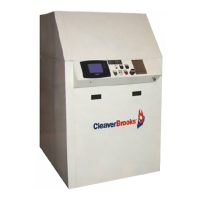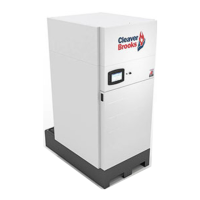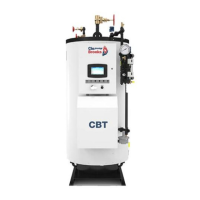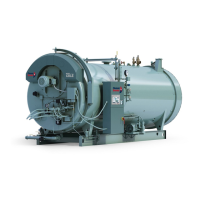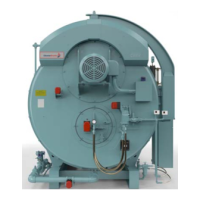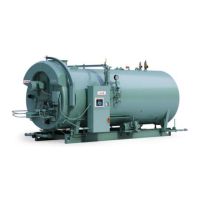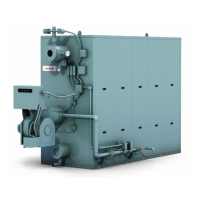750-265 4
FEATURES, continued
Access codes through the display allow for different levels of
setup.
— The OEM level allows for equipment to operate within
guidelines that they feel necessary for safe and effi-
cient operation of their equipment. The OEM makes
available the parameters that the installing contractor
needs for installation adjustments of the equipment.
— The installer setup information is customized by the
OEM. The access code for the installer level must be
obtained from the OEM.
— The User level allows for non critical adjustments for
the individual piece of equipment. These would
include but not limited to:
• Read the error log from CB Falcon.
• Monitor the input and output variables of the
controller.
• Read parameters from CB Falcon.
• CH and DHW setpoint adjustment.
Operational Features
Self Test
The Safety Processor performs Dynamic Self Checks that
supervise microcomputer performance to ensure proper
operation. The microcomputer tests itself and its associated
hardware with comprehensive safety routines. Any
malfunction will be detected by the microcomputer to cause a
safety shutdown and cause the Dynamic Safety Relay to de-
energize all safety-critical loads.
Initialization
The CB Falcon will start up in either the configured or
unconfigured condition. In the Configured condition it is ready
to operate a burner.
The CB Falcon is in the unconfigured condition whenever a
safety parameter requires editing (Commissioning). The Falcon
remains unconfigured and will not operate a burner
until all safety parameters have been reviewed and confirmed.
Safety Lockout.
The R7910A can be set up to maintain a lockout condition on
power interruption or to reset the lockout on a power
interruption.
Reset
Pressing and releasing the reset button (or the remote reset
input) always causes a lockout condition to be cleared, and
the microcomputer that operates the burner control part of the
CB Falcon to reinitialize and restart.
A safety lockout can also be reset through a writable
parameter from the system display through Modbus.
Fault Handling
The CB Falcon implements two kinds of faults: lockouts and
alerts.
• Lockout causes the burner control to shutdown and
requires manual or remote reset to clear the lockout.
• It always causes the alarm contact to close.
• Gets logged into the 15 item lockout history.
• Alerts include every other kind of problem that does not
shut the burner down. Examples of alerts are faults from
non–safety functions or abnormal events that are relevant
to an operator or end user.
• Alerts never require manual intervention to reset
them (an alert is not a condition, it is an event).
• Whether the alarm contact closes or not is
programmable by the OEM for each alert.
• Alerts are logged in the 15 item alert history and
sorted in chronological order. Only one instance of
each alert fault code occurs in the history,
corresponding to the most recent occurrence of the
alert.
Sensor Signal Conditioning
The analog sensor signal processing includes filtering to
reduce the effect of noise and spurious read events.
Operating Sensors will not cause a fault condition unless the
value is requested for control purposes. The Falcon will
trigger an Alert if an operating sensor is malfunctioning.
Safety Sensors (Sensors used as Limits, e.g. High Temp
Limit) include a comparison of redundant sensors. A safety
sensor mismatch or out-of-range will result in a safety
shutdown and Alarm.
Non-Volatile Memory
The CB Falcon will store the following items in non-volatile
memory:
• Factory configuration data
• Parameter Control Blocks
• All configuration parameters
• The 15 item lockout history
• Cycle and Time history
Lockout History
The lockout history will contain 15 records. Each record will
contain a snapshot of the following values as they existed at
the time of the lockout.
• Burner Lockout/Hold identifies the cause of the lockout.
• Burner State identifies the state of the burner control (e.g.
standby, purge, run).
• Burner Displayed Time: mm:ss is the displayed timer
used by the Burner Control at the time of lockout (e.g.
prepurge time, ignition time, etc.).
• Annunciator First-out is the first-out code for the lockout.
• Burner Run Time is the elapsed time of burner operation.
• Burner Cycle Count is the number of burner cycles
(based on the main valve being turned on).
• All analog sensor values (Inlet, Header, Outlet, Outdoor,
DHW, and Stack)
